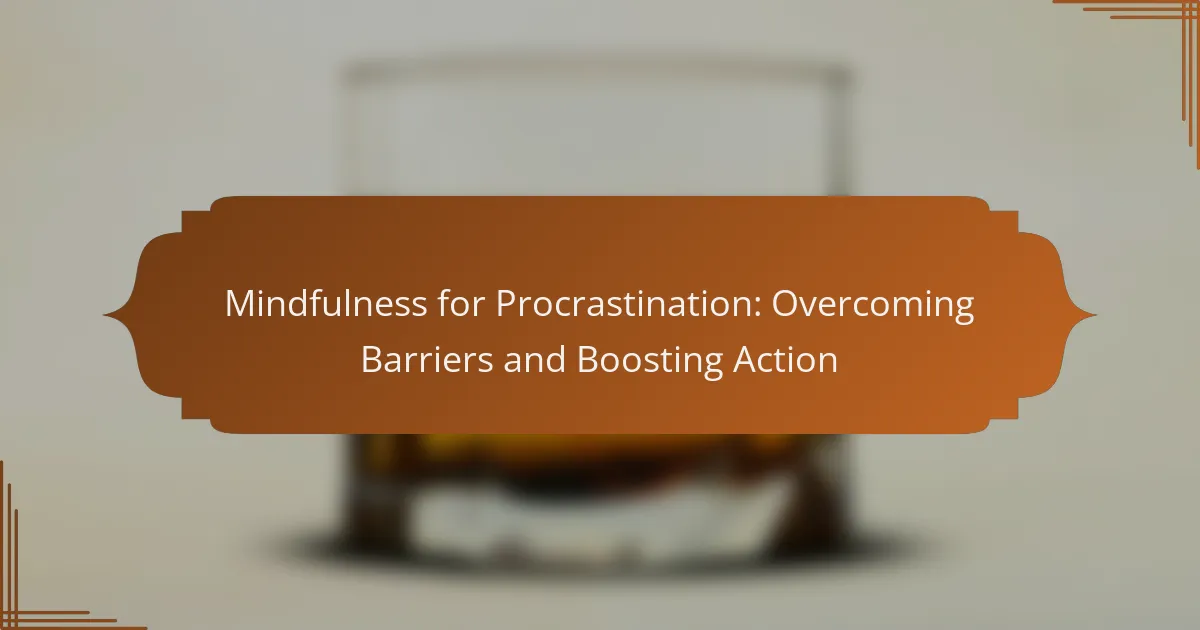Mindfulness offers powerful tools to combat procrastination by increasing awareness of our thoughts and emotions, enabling us to take decisive action. By incorporating techniques such as breathing exercises and mindful journaling into our daily routines, we can enhance focus and motivation, ultimately reducing the tendency to avoid tasks. Embracing mindfulness not only helps manage distractions but also fosters a more productive and engaged mindset.
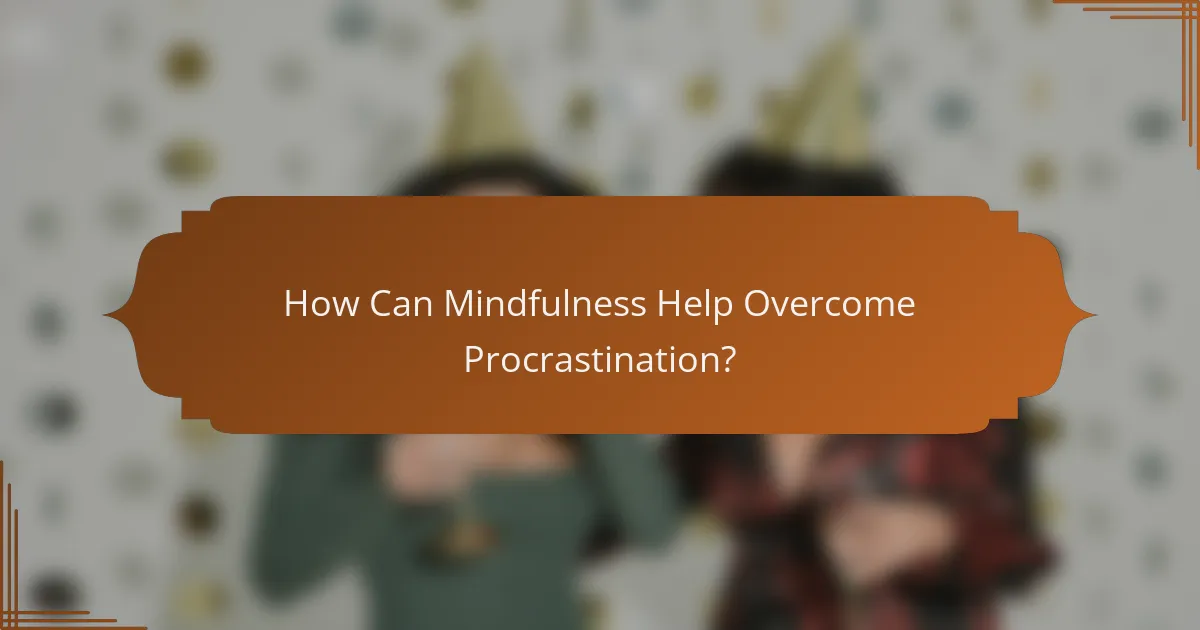
How Can Mindfulness Help Overcome Procrastination?
Mindfulness can significantly reduce procrastination by fostering a greater awareness of thoughts and feelings, which helps individuals take action rather than avoid tasks. By practicing mindfulness, one can develop skills to manage distractions and enhance motivation.
Reduces anxiety and stress
Mindfulness techniques, such as meditation and deep breathing, can lower anxiety levels and stress, which are common barriers to productivity. When individuals feel less overwhelmed, they are more likely to tackle tasks head-on rather than delay them.
Incorporating short mindfulness exercises into daily routines can help maintain a calm state of mind. For example, taking a few minutes to focus on breathing before starting a task can create a more relaxed approach to work.
Enhances focus and clarity
Practicing mindfulness improves concentration by training the mind to focus on the present moment. This heightened awareness allows individuals to prioritize tasks effectively and reduce the tendency to get sidetracked by irrelevant thoughts or distractions.
To enhance focus, consider setting specific time blocks for work where mindfulness is practiced beforehand. Techniques like the Pomodoro Technique, which involves working for 25 minutes followed by a 5-minute break, can be combined with mindfulness to boost clarity and productivity.
Promotes self-awareness
Mindfulness fosters self-awareness by encouraging individuals to observe their thoughts and behaviors without judgment. This awareness can reveal patterns of procrastination and help identify triggers that lead to avoidance.
Keeping a journal to reflect on feelings and actions related to tasks can enhance this self-awareness. Noting when procrastination occurs and the emotions involved can provide insights into personal habits and motivate change.
Encourages present-moment engagement
Mindfulness emphasizes engaging fully with the present moment, which can counteract the tendency to procrastinate. By focusing on the task at hand rather than worrying about future outcomes, individuals can increase their productivity and satisfaction.
To practice present-moment engagement, try techniques like mindful walking or eating, which can help reinforce the habit of focusing on current activities. This practice can translate into a more engaged approach to work tasks, reducing the likelihood of procrastination.
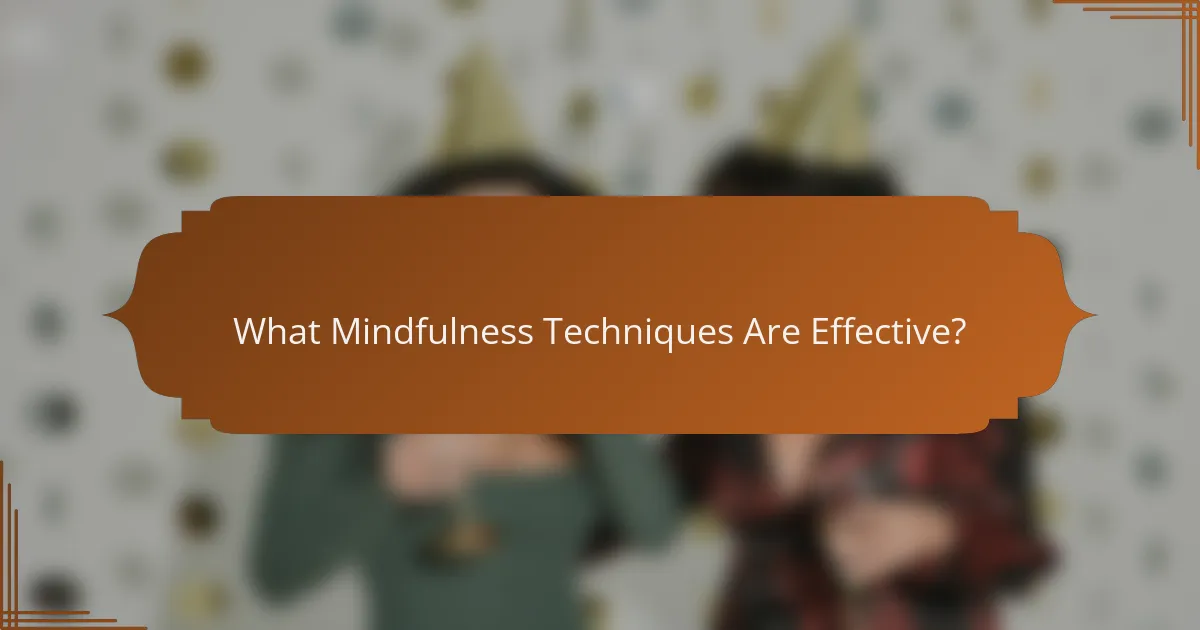
What Mindfulness Techniques Are Effective?
Effective mindfulness techniques for overcoming procrastination include breathing exercises, body scan meditation, mindful journaling, and guided imagery. These practices help increase awareness, reduce stress, and enhance focus, making it easier to take action on tasks.
Breathing exercises
Breathing exercises are simple yet powerful tools for enhancing mindfulness and reducing procrastination. Techniques such as deep diaphragmatic breathing can calm the mind and body, allowing you to refocus on tasks. Aim for a few minutes of focused breathing, inhaling deeply through the nose and exhaling slowly through the mouth.
To practice, find a quiet space, close your eyes, and concentrate on your breath. If your mind wanders, gently bring your focus back to your breathing. Regular practice can significantly improve your ability to manage distractions and initiate tasks.
Body scan meditation
Body scan meditation involves paying attention to different parts of your body, promoting relaxation and awareness. This technique helps you recognize physical tension that may contribute to procrastination. Spend about 10-20 minutes lying down or sitting comfortably, focusing on each body part from head to toe.
As you scan, notice any sensations, tightness, or discomfort. Acknowledge these feelings without judgment, which can help release tension and enhance your ability to concentrate on your tasks afterward.
Mindful journaling
Mindful journaling combines writing with mindfulness to clarify thoughts and feelings about procrastination. Set aside time each day to reflect on your tasks, emotions, and barriers to action. This practice can help identify patterns and triggers that lead to procrastination.
Start by writing freely for 5-10 minutes about what’s on your mind. Focus on your feelings regarding specific tasks and explore any fears or concerns. This can lead to insights that motivate you to take action.
Guided imagery
Guided imagery involves visualizing a peaceful scene or a successful completion of tasks to foster motivation and reduce anxiety. This technique can be particularly effective for overcoming procrastination by creating a mental image of success. Spend a few minutes each day visualizing yourself completing tasks with ease and confidence.
To practice, find a quiet space, close your eyes, and imagine a scenario where you successfully finish a project. Engage all your senses in the visualization, which can enhance motivation and clarity about the steps needed to achieve your goals.
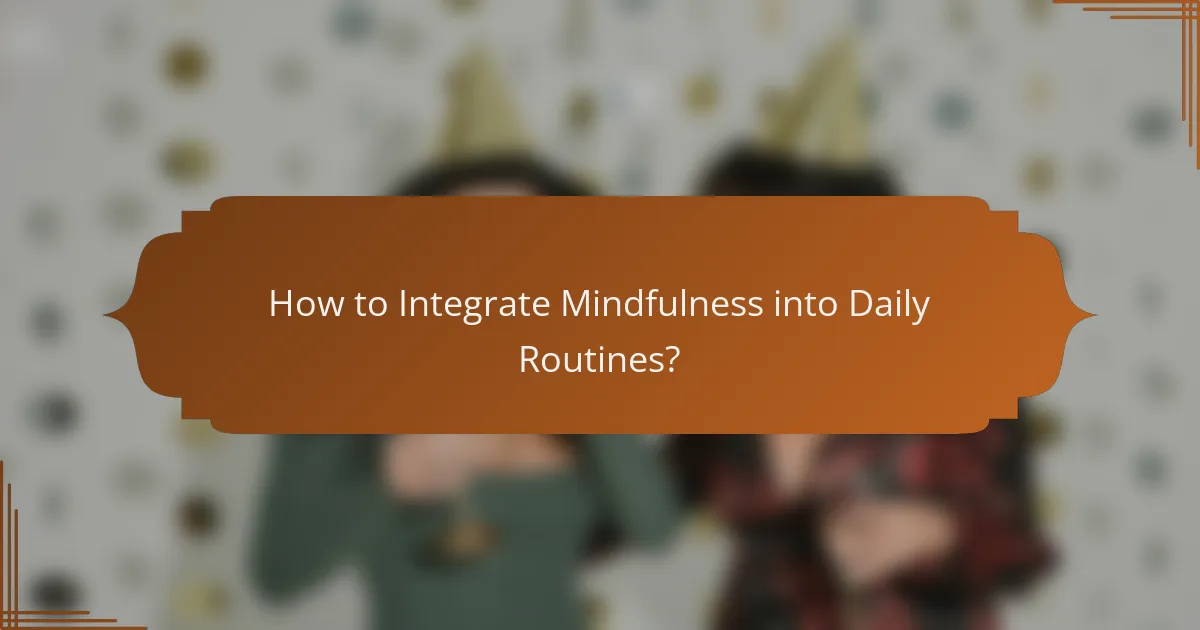
How to Integrate Mindfulness into Daily Routines?
Integrating mindfulness into daily routines can significantly reduce procrastination by enhancing focus and awareness. Simple practices can be woven into everyday activities, making it easier to stay present and motivated.
Set specific mindfulness times
Designating specific times for mindfulness practice helps establish a routine. Aim for short sessions, such as 5 to 10 minutes, either in the morning or during lunch breaks. Consistency is key; try to practice at the same time each day to build a habit.
Consider using reminders on your phone or calendar to prompt you. This can help reinforce the practice and ensure you prioritize mindfulness amidst a busy schedule.
Use mindfulness apps like Headspace
Mindfulness apps such as Headspace or Calm offer guided sessions that can fit into your daily life. These apps provide structured programs tailored to various needs, including stress reduction and focus enhancement.
Many of these apps offer free trials or basic versions, making them accessible. Explore different features to find what resonates with you, and set aside time to engage with the app regularly.
Practice during breaks
Utilizing breaks for mindfulness can refresh your mind and improve productivity. Even a few minutes of deep breathing or meditation can help clear mental clutter and enhance focus when you return to tasks.
Try to incorporate mindfulness techniques during short breaks, such as a quick body scan or mindful walking. This can help you recharge and reduce the urge to procrastinate.
Combine with daily tasks
Incorporating mindfulness into daily tasks can transform routine activities into opportunities for practice. For instance, focus fully on the sensations of washing dishes or the sounds of your environment while walking.
By being present during these tasks, you can cultivate mindfulness without needing extra time. This approach not only enhances your awareness but also makes mundane tasks more enjoyable.
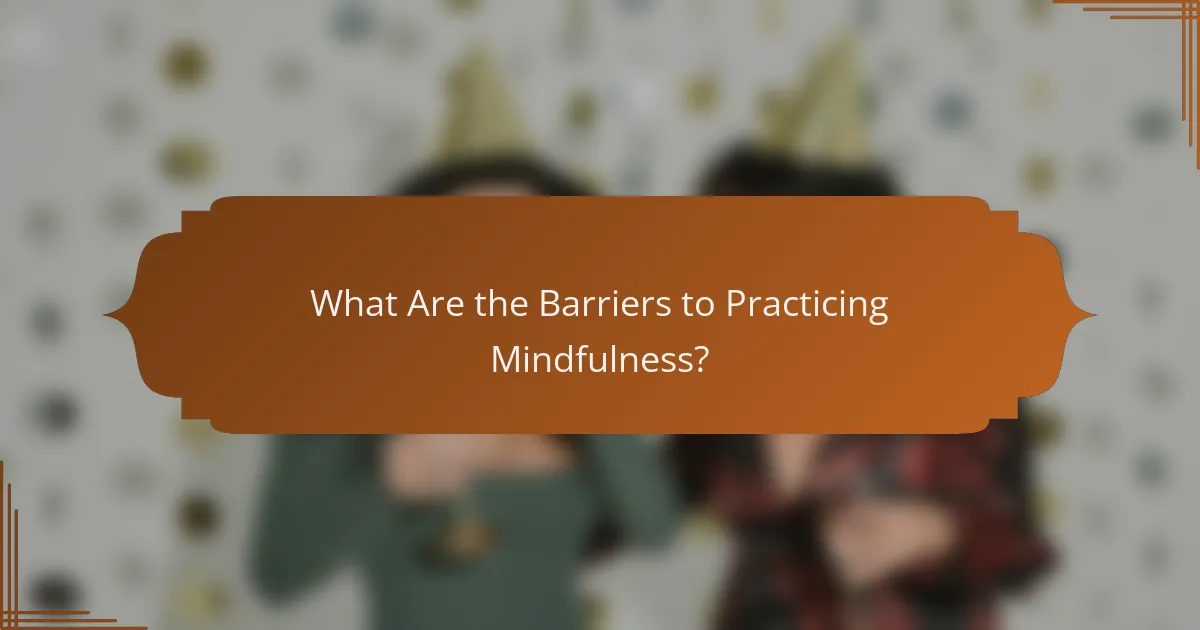
What Are the Barriers to Practicing Mindfulness?
Practicing mindfulness can be hindered by several barriers that prevent individuals from fully engaging in the process. Understanding these obstacles is crucial for overcoming them and enhancing mindfulness practice.
Lack of time
Many people feel they lack the time to practice mindfulness, often viewing it as an additional task rather than a beneficial activity. However, mindfulness can be integrated into daily routines, requiring only a few minutes each day.
To make it manageable, consider starting with short sessions of 5-10 minutes, gradually increasing the duration as it becomes a habit. Simple practices like mindful breathing or a quick body scan can be done during breaks or commutes.
Difficulty in maintaining focus
Maintaining focus during mindfulness exercises can be challenging, especially in a world filled with distractions. It’s common for thoughts to wander, which can lead to frustration.
To improve focus, try guided meditations or mindfulness apps that provide structure. Setting a specific intention for each session can also help keep your mind anchored to the practice.
Misunderstanding mindfulness
Some individuals may misunderstand what mindfulness entails, associating it solely with relaxation or meditation. Mindfulness is about being present and aware, which can be practiced in various forms beyond traditional meditation.
To clarify this, explore different mindfulness techniques such as mindful eating, walking, or even engaging fully in conversations. Recognizing that mindfulness can be woven into everyday activities can enhance its accessibility.
Resistance to change
Resistance to change is a common barrier when adopting mindfulness practices. People may feel uncomfortable stepping out of their routines or fear that mindfulness will require significant lifestyle adjustments.
Start by making small changes, such as dedicating a few minutes each day to mindfulness. Gradually incorporate more practices as you become comfortable, allowing for a smoother transition into a more mindful lifestyle.
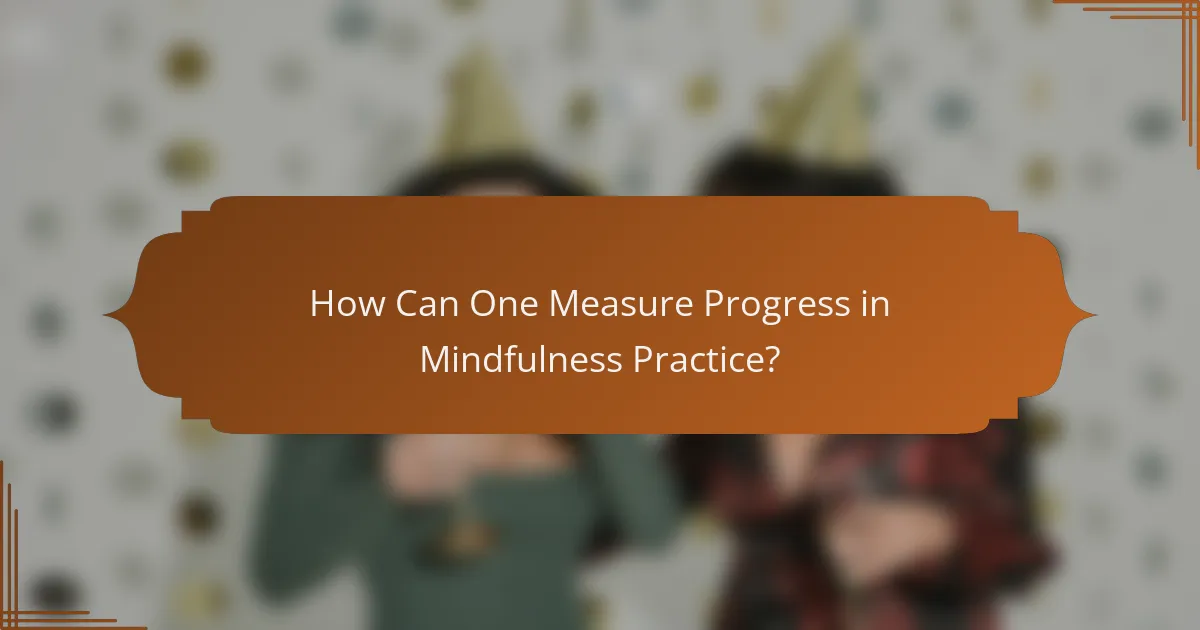
How Can One Measure Progress in Mindfulness Practice?
Measuring progress in mindfulness practice involves tracking personal growth and changes in behavior over time. This can be done through various methods that reflect improvements in focus, emotional regulation, and overall well-being.
Self-reflection journals
Self-reflection journals are a powerful tool for measuring mindfulness progress. By regularly writing about thoughts, feelings, and experiences, individuals can identify patterns and shifts in their mindset. This practice encourages deeper self-awareness and can highlight areas of improvement.
To effectively use a self-reflection journal, set aside time daily or weekly to jot down insights. Focus on specific mindfulness techniques practiced, emotions felt, and any changes in behavior. Over time, reviewing these entries can reveal significant progress and areas needing attention.
Consider including prompts in your journal, such as “What mindfulness techniques worked well today?” or “How did I respond to stress?” This structured approach can enhance the reflection process and provide clearer insights into your mindfulness journey.
